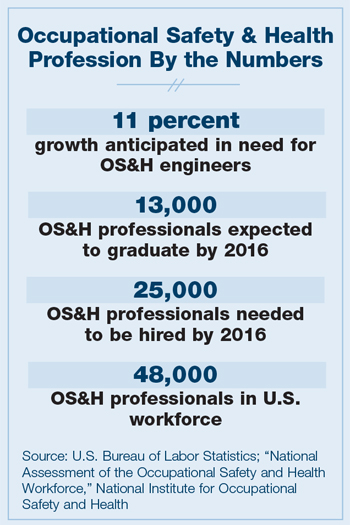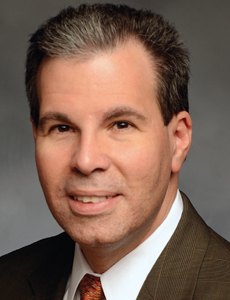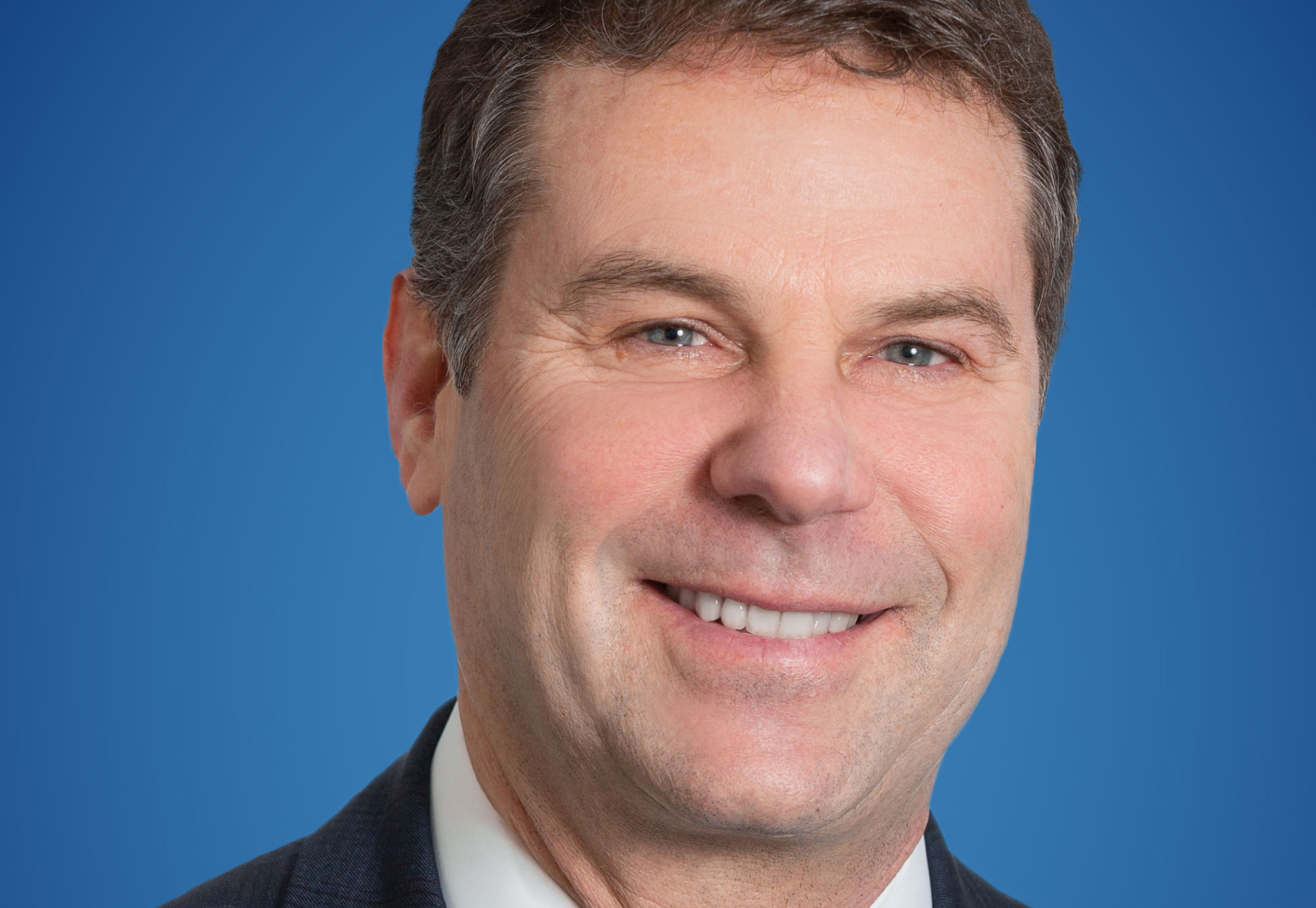Safety Professionals
In Demand

There are no hard statistics confirming a shortage of safety and health professionals, but there is a lot of circumstantial data.
An October 2011 study prepared for the National Institute for Occupational Safety and Health (NIOSH), for example, concluded that the need for health and safety engineers in 2011 and over the next five years “is substantially higher than the number estimated to be produced from … training programs.”
The U.S. Bureau of Labor Statistics predicts 11 percent growth in the number of health and safety engineers between 2012 and 2022.
In addition, a survey of members by the American Society of Safety Engineers (ASSE) found about 1 percent unemployment, and the 30 or so annual graduates of the University of Michigan Center for Occupational Health and Safety Engineering usually get hired before they graduate.
Some experts, however, say the shortage is not so much a lack of entry-level talent as it is of experienced safety and health professionals. They said that what organizations are missing are competent professionals who are knowledgeable about both the industry in question, and the resources and tools that professionals can offer.
As Skip Smith, senior director of risk management and insurance at HOA Inc. (Hooters of America) said in a recent Risk Insider article, “But these days, if you’re charged with overseeing a corporate risk management department, it is very difficult to fill a safety position. There are a limited number of qualified candidates with the required educational background, experience and unique set of skills.”
It takes time, obviously, to gain the credentials, experience and even the terminology necessary to make an impact on a worksite. But the clock may be ticking on the profession as baby boomers get ready to retire and the influx of professionals is lower than necessary to fill the gap.
Low Visibility
One problem is the low visibility of the profession to most young people, said Stuart Batterman, director, University of Michigan Center for Occupational Health and Safety Engineering.
“Typically, they don’t recognize the opportunities that are available in this field,” he said. “It’s also not the kind of field that most people have prior exposure to.”
For some industries, such as construction, manufacturing, and oil and gas, the need may be greater than others. Obviously, that’s because such industries are more hazardous than some, but it’s also because these sectors are more likely to have the increased risk of ramping up or ramping down operations. When that happens, the danger increases.
New employees, round-the-clock operations, different locales — all of them add uncertainty and potential risk to organizations. The continuing increase of Spanish-speaking workers as well as those native in other languages also makes it harder to educate and train employees.
As the difficulty mounts in finding experienced environmental, health and safety (known both as EHS or HSE) professionals, the number of consultants and service providers to fill that void is growing. Insurance companies and brokerages as well provide risk control services to their clients.
But consultants are generally not on the jobsite every day and have less insight into the daily demands of an organization.
The age issue is not one that will go away anytime soon.
“We have got a graying population,” said Carl W. Heinlein, senior safety consultant, American Contractors Insurance Group, a captive owned by 41 contractors around the country. “I can probably think of seven great safety jobs that are currently available right now. They can’t find quality, experienced people to fill them.”
The 2011 NIOSH study, prepared by Westat, projected that about 10 percent of safety professionals would retire within the next year, and estimated that a “large number” of such professionals are over the age of 50.
It forecast that employers would hire more than 25,000 more over the next five years, but that colleges were expected to graduate fewer than 13,000 HSE professionals. And the report noted that enrollment was projected to slightly decline over a five year period.
 The BLS noted that occupational safety and health specialists held 55,800 jobs in 2008, and projected employment to 62,000 in 2018, an increase of 11 percent.
The BLS noted that occupational safety and health specialists held 55,800 jobs in 2008, and projected employment to 62,000 in 2018, an increase of 11 percent.
Leaders in construction, oil and gas, and other industries, Heinlein said, “have been begging for quality safety folks.”
Those industries, in particular, are dangerous ones to be in. According to the Bureau of Labor Statistics, construction fatalities, while down 36 percent since 2006, still account for the highest number of fatal work injuries of any industry sector in 2013, the latest year for which results are available.
It’s more difficult to pin down the fatalities in the oil and gas industry as it is covered by several different BLS categories. Overall, construction and extraction occupations accounted for 818 fatalities in 2013, or 18 percent of all workplace fatal injuries. Transportation fatalities numbered 1,184 or 27 percent of all workplace deaths.
BLS indicates that organizations involved in oil and gas extraction have the highest percentage of EHS employment in the private sector, at nearly 1 percent of all positions. Another six-tenths of 1 percent are employed in petroleum and coal products manufacturing.
Hands-on Experience
To be effective, health and safety professionals need hands-on experience in troubleshooting problems, said Scott Harris, director of EHS advisory services at UL Workplace Health & Safety.
“We really haven’t seen a shortage,” he said.
“When I am out talking to folks, they have never said to us, ‘We can’t find someone.’ I have heard often, ‘It’s hard to find a good one,’ meaning they are looking for certain key skills and the young people just don’t have them.”
The ability to research and “textbook knowledge” are what college graduates can bring to a job, he said, but they often lack industry experience, the ability to solve problems, people skills and presentation skills, so they can command attention during meetings.
It’s also important to understand the value of redesigning a process or engineering out the risk instead of focusing just on training and education, said Matt Kupiec, assistant vice president of construction risk engineering at ACE Group.
And, he noted, it’s not always necessary to re-invent the wheel. There are vendors and service providers that have created products to meet many safety demands.
It takes about two years for an entry-level person to become “well versed as a generalist.” — Brion Callori, senior vice president, engineering and research, FM Global
At FM Global, which focuses a lot of attention on commercial property risk, Brion Callori, senior vice president, engineering and research, noted that it takes time for property risk engineers to become fully proficient.
FM Global hires between 100 and 150 property risk engineers yearly.
There are two levels to proficiency, he said.
“We expect someone out of engineering school to think like an engineer. We have to give them cross-discipline training and have developed a hands-on training approach to expedite the process.”
It takes about two years for an entry-level person to become “well versed as a generalist,” he said, and then the carrier moves the focus to specific natural hazards, such as windstorms, power generation, chemicals, etc.
“It probably takes another three years of that to become top flight and really specialized in something,” Callori said.
Contractor Risk
One issue with the energy industry in particular, said Jay Doherty, partner, workforce sciences institute, Mercer, is the tremendous number of contractors on major projects, with investment levels ranging from $100 million to several billion dollars.
“You have less control and more variation in the skills, compliance and knowledge of safety [with contractors],” he said.
“The industry has, unfortunately, had incidents, serious incidents, more often with the subcontractors than with the prime contractor or operator.”
BLS statistics bear that out — for all industry sectors.
Fatal injuries of contractors accounted for 17 percent of all workplace deaths in 2013, and half of all contractors who were fatally injured were working in construction and extraction occupations.
The importance of experience when it comes to HSE professionals is not so much on the increasing compliance requirements but on problem-solving and prevention, Doherty said.
The career structure and the time to competence is complex for HSE, he said, because “the discipline is not simply defined by hierarchy or level. Often the best HSE experts don’t begin in that role.” Development requires broad knowledge not only of OSHA and other governmental regulations, but also knowing the protocols of companies and specific industries.
It also depends on the span of control, Doherty said. It takes more than HSE professionals to look after safety. Supervisors often perform a compliance role and when cost pressures reduce spans or there is simply a lack of experience in the workforce, there is greater likelihood of safety incidents, he said.
“Companies need to examine the career paths for their HSE professionals,” he said, “to make sure top talent is rewarded commensurate with other critical skills. That sends a clear signal of the priority placed on safety and the environment.”
But, some companies just don’t value the position enough. When times are tight, occupational health and safety professionals are often near the top of the chopping block, and many organizations continue to look at the profession as an expense instead of a way to improve production and margin.
“This is a margin-making opportunity. It’s an opportunity for a company to look at it more as a business asset than as a cost or expense of the operation.” — James Merendino, vice president and general manager, commercial insurance risk control services, Liberty Mutual
As UL’s Harris noted, the profession has its own gallows humor: It’s always safety first … unless it interferes with production or “gets in the way of something else.”
But, said James Merendino, vice president and general manager, commercial insurance risk control services, Liberty Mutual, effective safety and risk management strategies affect both the top and bottom lines of a company.

James Merendino, vice president and general manager, commercial insurance risk control services, Liberty Mutual
“This is a margin-making opportunity,” Merendino said.
“It’s an opportunity for a company to look at it more as a business asset than as a cost or expense of the operation.”
It’s more than ensuring regulations are complied with, he said. It’s making safety a strategic priority of the organization, which may result not only in fewer and less severe injuries, but also in lower insurance premiums, and better terms and conditions.
It also is less disruptive of production deadlines, and more protective of an organization’s brand and an industry’s reputation.
“Safety has to be elevated to the position that production is,” said George Cesarini, vice president of construction risk engineering, ACE.
“Organizations need to elevate safety from, ‘Insurance wants this’ or ‘OSHA wants this’ to elevating it to the same level as production, to making it a core value within the organization.”
Finding the experienced professionals to fill that role, however, may continue to be a problem.










